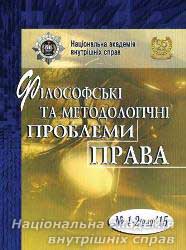Semiotics at the Turn of the Nineteenth and Twentieth Centuries and its Importance for the Formation of Modern Semiotics of Law
Keywords:
Philosophy of Law, Semiotics of Law, Aesthetics of law, history of semiotics, sign system of law, legal reality
Abstract
The article deals with Semiotics at the turn of the Nineteenth and Twentieth centuries as an important source of forming of Semiotics in the second half of the Twentieth century. The content of semiotic ideas of prominent thinkers of this period in connection with the subsequent semiotic tradition is revealed. The importance of these approaches to solve many problems of Semiotics of Law and Philosophy of Law on the modern level of development is described. Author assumes that the initial development of semiotic ideas in the territory of the Russian empire is connected primarily with the work of A. Veselovsky, M. Hrushevsky and O. Potebnya. Based on the previous ideas of researchers language O. Potebnya considers internal form of speech, human communication, poetic thinking, mythical thinking and other themes in the works of «Thought and Language», «From the notes on the theory of literature», «From the notes on Russian grammar». Theoretically, systemic and structural positions expressed in these works, aimed at identifying the cognitive parallels mining linguistic tools on literary texts (and especially – in the folklore material) are reflected in the further development of Semiotics. If at first glance, poetic language is completely different from the language of science and the language of law, upon close examination you can find a lot of this and to conduct certain parallels – that such issues today determines the object of interest of the world famous experts on the Semiotics of Law. Modern researchers in the field examined the stable legal iconic constructions and point to the prevalence of repetitive forms in the law, because using of steady idiom (cliché) as a structural units of the legal text is a characteristic feature of the language of law, that is determined necessity of complying of accuracy of names of concepts. Today in linguistics to refer to various locales used except cliché terms like linguistic stereotypes, idioms, idioms, clichés, group templates favorite momentum stereotyped turns, each of which has its own peculiarities, and to conceptual field, which form the linguistic phenomena, approaching sayings, quotations, aphorisms, maxims and etc.Downloads
Download data is not yet available.
Abstract views: 518 PDF Downloads: 268
Issue
Section
Methodology of law
Copyright (c) 2017 Philosophical and Methodological Problems of Law

This work is licensed under a Creative Commons Attribution-NonCommercial-NoDerivatives 4.0 International License.
- Authors reserve the right to authorship of their own work and transfer to the magazine the right of the first publication of this work under the terms of the Creative Commons Attribution License, which allows other persons to freely distribute published work with mandatory reference to authors of the original work and the first publication of an article in this magazine.
- Authors have the right to enter into separate additional agreements on non-exclusive dissemination of the work in the form in which it was published in the journal (for example, to post an article in the institution's repository or to publish as part of a monograph), provided that the link to the first publication of the work in this journal is maintained.
- The journal's policy allows and encourages the posting of articles by authors on the Internet (for example, in electronic storehouses of institutions or on personal websites), both before the submission of this manuscript to the editorial office and during its editorial processing, as this contributes to the creation of a productive scientific discussion and positively affects the efficiency and dynamics of citing the published work.




